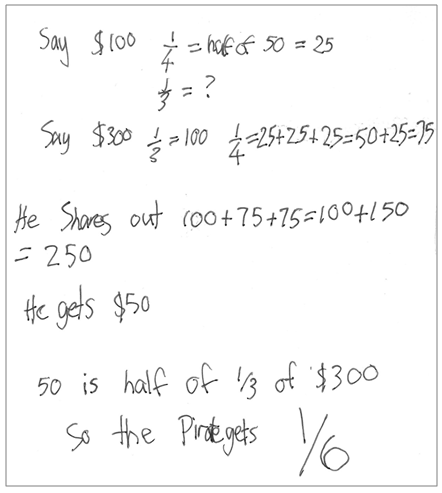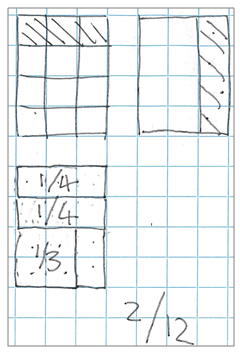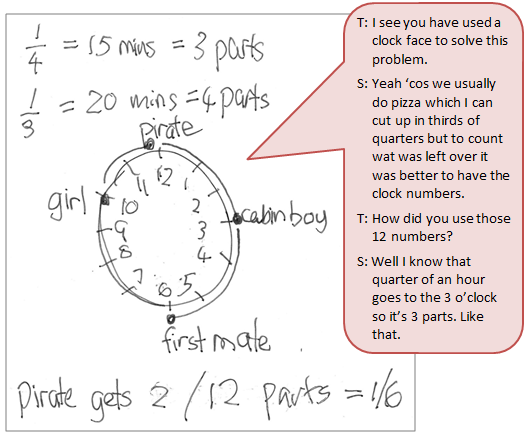The purpose of this activity is to engage the students to use their knowledge of fractions and additive strategies to complete a whole.
This activity assumes the students have experience in the following areas:
- Understanding the meaning of the numerator and denominator in a fraction.
- Expressing a part-whole relationship as a fraction.
- Finding a fraction of a whole number.
- Add simple fractions.
The problem is sufficiently open ended to allow the students freedom of choice in their approach. It may be scaffolded with guidance that leads to a solution, and/or the students might be given the opportunity to solve the problem independently.
The example responses at the end of the resource give an indication of the kind of response to expect from students who approach the problem in particular ways.

A pirate shares some of his treasure.
He gives ¼ to the cabin boy, ¼ to his first mate and ⅓ to the girl who feeds his parrot.
How much of his treasure does the pirate have left?
The following prompts illustrate how this activity can be structured around the phases of the Mathematics Investigation Cycle.
Make sense
Introduce the problem. Allow students time to read it and discuss in pairs or small groups.
- Do I understand the situation and the words? (Students may need support to recognise that the amount of treasure is not given, but the shares can still be determined.)
- Do I understand the fractions in this problem?
- Can you visualise the shares for each crew member in some way? Who gets the most? Who gets the least?
- What will my solution look like? (The solution will be the fraction of the treasure that the pirate gets. That answer will need to be justified, by working out the shares of the other crew members.)
- How will you deal with the amount in the chest being unknown?
- What is the ‘one’ in this problem?
Plan approach
Discuss ideas about how to solve the problem. Emphasise that, in the planning phase, you want students to say how they would solve the problem, not to actually solve it.
- What else do I need to know to get started?
- How might I represent the whole, the treasure chest?
- How will I record my working using a diagram or equations?
- Can I work out the result of adding the fractions? Do I have the maths I need?
- How will I work out the pirate’s fraction?
- What tools (digital or physical) could help my investigation?
Take action
Allow students time to work through their strategy and find a solution to the problem.
- Am I showing my workings in a clear way using a diagram or equations?
- Do my calculations seem correct? Do they match my thinking about who gets most and who gets least?
- How could I check my answer?
- Does my solution seem reasonable, and does it solve the problem?
- Is there another possible way to solve this problem that is more efficient?
Convince yourself and others
Allow students time to check their answers and then either have them pair share with other groups or ask for volunteers to share their solution with the class.
- Is my working clear for someone else to follow?
- How would I convince someone else I am correct?
- Would my answer work in a different situation? What kind of situation?
- What have I learned about using fractions?
- Which ideas or tools worked well in my investigation?
Examples of work
Work sample 1
The student nominates the amount of money in the treasure chest and calculates fractions of that amount to find the pirate’s share.
Click on the image to enlarge it. Click again to close.
Work sample 2
The student draws an area diagram to determine the shares of each crew member.
Click on the image to enlarge it. Click again to close.
Work sample 3
The student uses a clock representation (circular region) and divides the region up to determine the share for each crew member.


